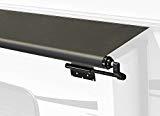If you happen to own an RV, you probably have or at least heard of slide-outs in them. A slide-out in an RV is a part or coach in an RV which actually moves outwards and creates some more living space inside the RV.
Most of the new RV's purchased today provide you with an option to have this amenity. They offer some luxury and comfort for sure, but they can also have other types of problems associated with them.
Why Should You Get a Topper Canopy?
One of the ways to avoid problems is to get a topper canopy for your slide-outs. Slide-out toppers or slide-out awnings as they are called in some cases are canopies or awnings. They protect the slide boxes of your RV. It protects your slide-out from external forces such as water, dirt, droppings, twigs, and debris. It also helps to insulate your slide-out from the sun, which reduces heat and in turn makes your vehicle perform better.
Here is what makes it a great choice.
- A slide-out topper can be attached to the slide-out of your RV.
- You can attach it to the body of the coach.
- It also comes with a roller tube attached to the outside of the RV coach, so that means if any debris or other material is on the topper, it will fall off once you roll the topper in.
- Plus, it also keeps the roof of the slide-outs of the RV away from stuff because of the space between the topper and the roof of the slide box.
- Slide-toppers in RV's helps reduce the amount of maintenance you require because of the additional unit sticking out of your vehicle.
While camping out for a few days or weeks, you are bound to have your slide-out open to enjoy that extra space and comfort. Depending on where you camp, this means that the top of your slide box will be subjected to the elements of nature and you'll see all kinds of leaves, debris, pines and other material on the roof of your slide-out.
In the absence of a slide-out topper, you will need to constantly brush off all these materials frequently because if you don't, these debris and other materials will go inside when you close the slide-out. This can potentially damage the seal of your slide-out.
Slide-out toppers can save a lot of maintenance money if you own an RV with a slide-out in it.
Do Slide-Outs Without Canopies Leak?
There can be leaks in the slide-outs of your RV for a variety of reasons and it is actually very common for RV's with slide-outs in them to experience leaks at some stage of the other.
One of the main causes for leaks in a slide-out is because of the lack of maintenance or slide-out awning on the roof of the slide-out. While the slide is out on your RV, it can accumulate a lot of debris, leaves, twigs, pines and other materials. If not maintained properly or if an awning is not installed, while you close the slide-out, the material goes inside with it. This causes the seal of the slide-out which can lead to leaks in it at a later stage. It is always crucial to keep the seal of the slide box intact. Otherwise, in the event of heavy rain or just water pouring over the roof of your slide-out, without any protection from an awning and the leaks already formed, water can accumulate inside the RV.
But even with a slide-out topper, an RV can experience leaks. This can happen due to cracks in the box which can potentially let moisture in. Another cause is window seals. If the slide-outs have windows, a potential leak could occur with moisture seeping through the seals of the window.
Another reason could be if the RV is not leveled properly. If the weather seals make imperfect contact with the slide boxes, or maybe if they are dried or even fractured, a leak could occur.
One thing which can help you to find out the root of the leak is to check the sides of the leak. Leveling problems usually cause leaks on the same side of the slide box. Due to the exposure to elements like excessive heat or extremely hot or cold temperatures, the weather seals of slide-outs may get damaged. This damage in the weather seal can allow water to enter the area inside the RV and potentially ruin content inside it.
In short, yes, slide-out without canopies do leak, and the leaks can occur due to a variety of reasons. But even with an awning or topper installed, you are not guaranteed to be leak-proof as there are other factors at work as well in this situation.
Benefits and Drawbacks of RV slide-out topper
There are several benefits as well as drawbacks with installing slide-out topper in your RV. Let's take a look at a few of them.
Benefits
- Slide-out toppers are great to protect your slide boxes from the harsh weather, be it the sun, the rain or even snow.
- They help you keep debris, leaves, pine cones and any other unwanted material off the roof of your slide box.
- Without a slide-out topper, RV users would need to sweep or clean off the roof of the slide boxes after every use before sliding the boxes in to prevent any damage in the future. Thus a lot of maintenance is required without a slide-topper.
- The structure of the awnings help the rain and debris slide off the roof of the box easily without any hassle. This is due to the roller tube attached to it which sweeps off all the debris once you roll it in.
- Slide toppers help reducing leaks in the slide boxes of the RV by keeping the seals intact. The seals can get damaged if debris or other unwanted material get into the RV while closing it.
Drawbacks
- Slide-out toppers can roll out when you open the slide box of an RV. Depending on how much you slide out, there will be some awning left on the roll. In short, there is always more material of the awning left on the roll that is extended as a part of the topper.
- In extremely windy conditions, the topper might start to flap and eventually flatten out. Slide toppers are generally not supposed to touch the roofs of the slide boxes and just sit on an inclined angle. This flatness can cause damage to the roof of the slide box when the wind keeps up and the slide-out topper keeps flapping and hitting the roof of the slide box.
- Like most parts and accessories associated with an RV, slide-out toppers can be expensive to purchase and install.
How To Install A Slide-Out Topper?
The following are the detailed steps to install a slide-out topper on your RV-
- The first step is to install the topper rail. Firstly, keep the fabric along with the roller tube in a clean place; it will prevent damage to them.
- After marking the points for marking brackets, drill holes into the positions you marked.
- The next step is to install the left arm. This should be done on the left-hand side of the roller tube. Next, align the clip holes and install the coter R-Pin. The same procedure is to be followed for the right-hand side as well.
- Next, you should widen the opening of the topper rail and remove any sharp edges which might damage the awning.
- Before starting with the installation, pull out the slide box a good 8-10 inches. For the installation, unroll some of the awnings form the roller tube and lift it to the height of the rail. Next, you should advance the assembly through the rail while another person keeps the assembly level. Next, caulk all the holes you had drilled and mount the brackets in these holes. After centering the slide topper, install the screws.
- The last step is to align the awning properly. Then install Tek screws into the rail at each end. This secures the fabric.
- Finally, remove the cotter pin from the left and right-hand side torsion rod. The installation process is complete.
How To Measure, Order And Replace Your RV Slide Topper?
If you need a new awning for the slide-box of your RV, you can order them from many local and online retailers present in the market today. One of them is Lippert Components. They allow to quickly order the awning you want based on the measurements you provide.
Taking measurements for an awning is actually quite easy. They require a few of them -
- The measurement from one end-cap to the other of the rail. This can vary depending on the size of your slide box.
- The second measurement is the depth. This is the distance from the wall to the outside of the box when completely pull out.
After you have the measurements, there are a few more details you need to provide before you can order. One of them is if you have a metal wrap. The second option is whether the fabric is connected directly. You can also decide on a color. Once you have all these details, you can visit the website, enter your measurements and other details, fill in your address details and other shipping information and then simply order your awning.

The steps for replacing the slide topper are as follows
- The first step is to remove the lock-nuts at each end. You can use an Allen nut or Philips head screw to do this.
- The next step is to remove the anti-billowing device completely.
- Unroll the fabric wholly and slowly off the roller. When it is completely unrolled, pin two screwdrivers through the shafts to keep the springs from unloading.
- Now move over to the end and tug at the awning until it starts sliding out of the roller. This step is going to remove the fabric from the roller completely.
- Clean the shaft and file any sharp edges which might damage the new fabric.
- Take the new fabric and start sliding it in. Insert one side into the roller and the other in the shaft. These need to be pulled simultaneously. You might need some lubricant if it gets hard to slide the topper into the shaft or roller. Perform this stage very slowly and completely pull the new fabric over the roller. Ensure that the fabric is centered by measuring the distance between the two end-caps.
- Slowly, start rolling back the new fabric into the roller make slight adjustments as required. The process of replacement is complete without any professional help.
Yes, that was a quick way to save a few hundred dollars. What do you think of it? Let us know in the comments below.

